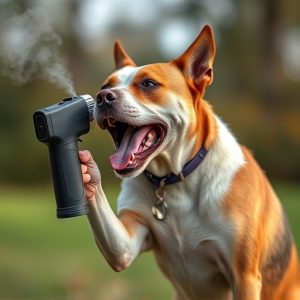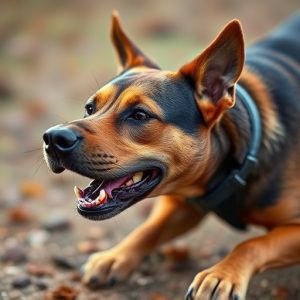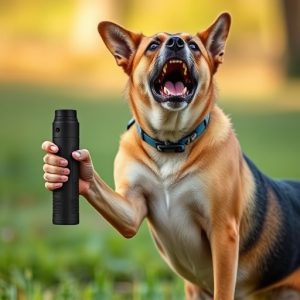Pepper Spray for Aggressive Dogs: Safety, Choice, Technique, and Legalities
Dog aggression, driven by fear or abuse, requires careful navigation. Recognizing warning signs is k…….
Dog aggression, driven by fear or abuse, requires careful navigation. Recognizing warning signs is key. Pepper spray (mace) offers a controversial yet effective solution, with the 'best mace concentration' balancing animal deterrence and health risks. Lower concentrations (1%-2%) are suitable for general deterrence, while higher strengths (up to 10% capsaicin) are indicated for aggressive dogs. Proper application targets the dog's face, focusing on eyes, nose, and mouth, using short bursts at a safe distance (3-4 feet). Local laws vary, so understanding regulations is crucial. Always use as a last resort after exhausting other deterrents with responsible handling, storage, and training.
In many situations, aggressive dog encounters can be unexpected and life-threatening. Pepper spray, or mace, has emerged as a potent tool for self-defense against such dogs. This comprehensive guide explores the most effective techniques and considerations for using pepper spray on aggressive canines. We delve into understanding canine aggression, safety protocols, choosing the ideal best Mace concentration for dog defense, application methods, and legal frameworks surrounding its responsible use.
- Understanding Dog Aggression and Pepper Spray Safety
- Key Factors in Choosing the Best Mace Concentration
- Application Techniques for Effective Dog Defense
- Legal Considerations and Responsible Use of Pepper Spray on Dogs
Understanding Dog Aggression and Pepper Spray Safety
Dog aggression can stem from various factors, including fear, territory protection, or a history of abuse. Recognizing warning signs like growling, snarling, or stiff body language is crucial when dealing with potentially dangerous dogs. Pepper spray, often referred to as mace, has emerged as a controversial yet effective tool for dog defense. When considering the best mace concentration for dog defense, it’s essential to understand that higher concentrations aren’t always better; a balanced formula optimized for animal deterrence without severe health risks is ideal.
Safety precautions are paramount when using pepper spray. It should only be deployed as a last resort when facing an aggressive dog, and users must adhere to instructions carefully. Proper ventilation is critical, and spraying should be done away from human eyes and sensitive areas. Regular training and practice can help individuals build confidence in their ability to handle aggressive dog encounters safely and responsibly.
Key Factors in Choosing the Best Mace Concentration
When selecting the best mace concentration for dog defense, understanding key factors is crucial. The primary consideration is the level of protection needed. Different concentrations offer varying levels of potency, with higher strengths designed for more aggressive dogs or extreme self-defense scenarios. For general dog deterrence, a lower concentration (e.g., 1% to 2%) can be effective without causing undue harm.
Additionally, the type of mace and its active ingredients play a significant role. Look for products containing proven effective substances like oleoresin capsicum (OC), which is known for its irritant properties. The application method is also important; spray-on maces offer convenience and ease of use in various situations. Always consider safety guidelines, usage instructions, and any legal restrictions regarding self-defense tools to ensure responsible and effective dog protection.
Application Techniques for Effective Dog Defense
When using pepper spray against an aggressive dog, proper application techniques are crucial for maximum effectiveness and safety. Aim for the dog’s face, specifically its eyes, nose, and mouth. This area has numerous nerve endings, making it highly sensitive to irritants like pepper spray. Hold the canister at a safe distance, typically 3-4 feet away, and spray in short bursts to avoid wind blowing the solution back towards you. Aim for direct contact with the dog’s face to ensure the best chance of neutralizing its behavior.
The best mace concentration for dog defense is generally a high-strength formula designed specifically for animal control. These can contain up to 10% capsaicin, the active ingredient responsible for the burning sensation. Choose a brand that offers precise spraying mechanisms and check local laws regarding the use of pepper spray on animals. Practice your application techniques in controlled environments before encountering an aggressive dog to ensure you’re prepared and confident in using this defense mechanism effectively.
Legal Considerations and Responsible Use of Pepper Spray on Dogs
When considering the use of pepper spray, or mace, as a defense against aggressive dogs, it’s crucial to be aware of the legal implications in your region. Different areas have varying regulations regarding the possession and use of such agents, so it’s essential to research and understand local laws before purchasing any dog defense spray. Some jurisdictions may allow its use only for law enforcement or specific self-defense scenarios, while others might permit it with a permit or under certain conditions.
Responsible use is equally vital. Pepper spray should be a last resort when all other methods of deterring an attack have failed. The best mace concentration for dog defense should be tailored to effectiveness and safety. Users must be trained in its application, aiming for the eyes and nose to cause temporary incapacitation without causing permanent harm. Proper storage and handling are also critical to ensure the spray remains effective and prevents accidental discharge or misuse.
When it comes to defending against aggressive dogs, pepper spray can be a powerful tool. By understanding dog aggression, choosing the right mace concentration, and learning effective application techniques, you can ensure your safety while navigating legal considerations. The best mace concentration for dog defense should offer a strong yet controlled effect, allowing for quick de-escalation without causing long-term harm. Always use pepper spray responsibly and in accordance with local laws to protect both yourself and the animal.


